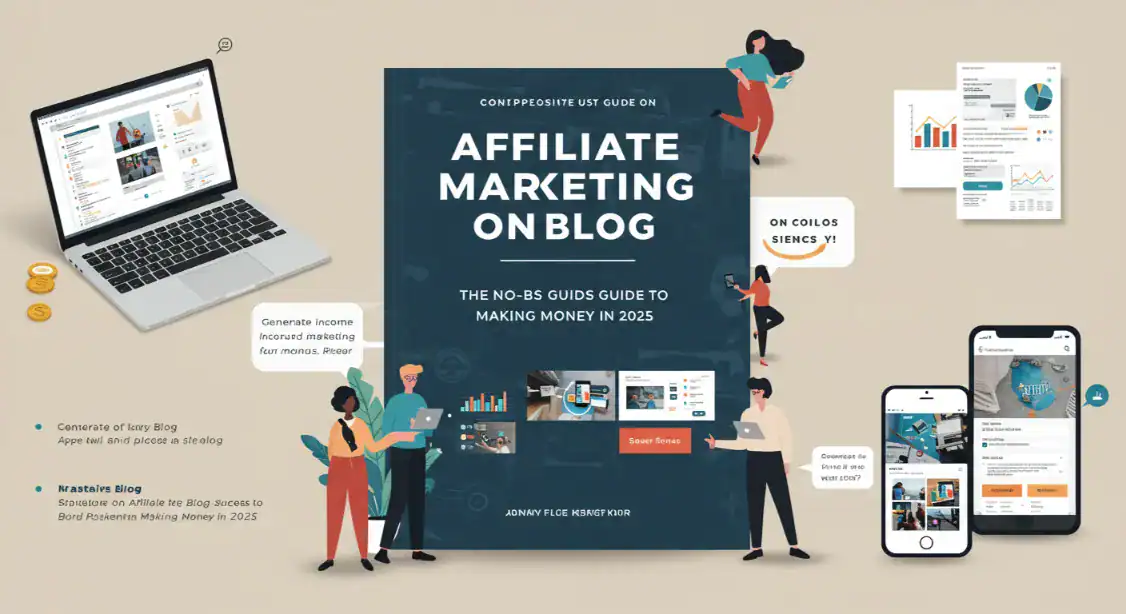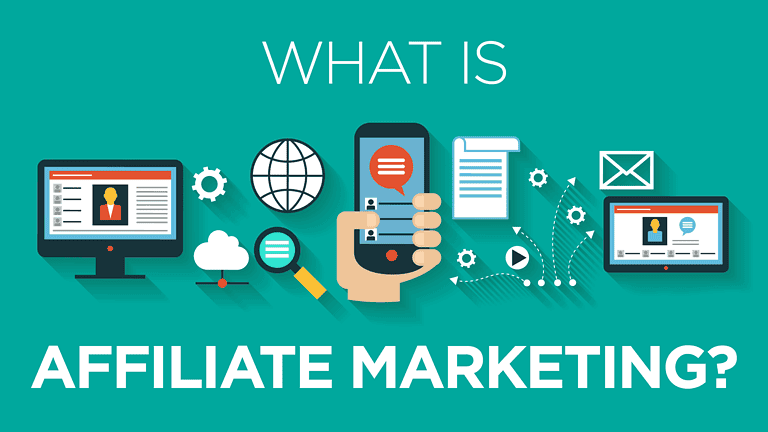Affiliate Marketing Blog: How to Earn $2K/Month [2025]
Affiliate marketing on a blog means you write about stuff, add special tracking links, and get paid when readers buy through those links.
That’s it. No fancy products to create. No inventory to manage. Just connect people with things they might want and collect your cut when they buy.
Key Takeaways:
- Focus on Priorities: Identify and concentrate on tasks or goals that add the most value to your objectives. This prevents distractions and ensures efficiency.
- Effective Communication: Clear and concise communication is essential for collaboration, problem-solving, and achieving desired outcomes.
- Adaptability: Be flexible and willing to adjust strategies when faced with unexpected challenges or changes in circumstances.
- Continuous Learning: Invest time in acquiring new knowledge and skills to stay relevant and improve performance over time.
- Time Management: Plan and allocate resources wisely to maximize productivity while avoiding burnout.
- Collaboration: Foster teamwork by leveraging the strengths of individuals to achieve shared goals and create innovative solutions.
Why Blogs Work for Affiliate Marketing
Blogs stick around. Unlike social media posts that vanish in hours, blog content works for you for years. You write it once, it ranks in Google, and people find it forever. A blog post I wrote three years ago still makes me money every month. I don’t touch it. It just sits there, working.
People trust blogs more than ads. When someone reads your thoughts about a product, they feel like they’re getting advice from a real person. Because they are. You build trust over time. Trust turns into clicks. Clicks turn into cash.
Your blog belongs to you. Not to Facebook or Instagram or whatever platform might change the rules tomorrow. You own it. You control it. Nobody can take it away.
Setting Up Your Affiliate Blog
You need a few basic things to start:
-
A domain name that doesn’t sound stupid
-
Hosting that doesn’t crash every time more than ten people visit
-
WordPress (or another platform if you hate making money)
-
A simple, clean design that loads fast
That’s the technical stuff. The hard part comes next — figuring out what the hell to write about.
Pick one topic. One. Not ten. Not five. One thing you know about and care about. Trying to cover everything means you’ll connect with nobody.
If you love camping gear, write about camping gear. If you know about dog training, write about dog training. If you’re into fancy coffee machines, write about those overpriced caffeine dispensers.
Finding Affiliate Programs Worth Your Time
Most affiliate programs suck. They pay pennies and treat you like garbage. Find the good ones.
Where to find decent affiliate programs:
-
Amazon Associates (easy to join, low commissions but converts well)
-
ShareASale (thousands of merchants in one place)
-
CJ Affiliate (formerly Commission Junction, lots of big brands)
-
Direct programs from companies you actually use
Look beyond the commission percentage. A program that pays 50% sounds amazing until you realize the product costs $2. A 5% commission on a $1,000 product puts more money in your pocket.
Check the cookie duration too. Some programs give you credit if someone buys within 24 hours of clicking your link. Others give you 30 days or more. Longer is better.
Creating Content That Actually Makes Money
Content is where most people screw up. They either write boring, generic crap nobody wants to read, or they go full sleazy salesperson and chase everyone away.
Content types that actually work for affiliate marketing for bloggers:
-
Detailed product reviews based on actual experience
-
“Best of” lists that solve specific problems
-
Tutorials that naturally incorporate affiliate products
-
Comparison posts that help people choose between options
-
Resource pages with your top recommendations
The secret? Actually use the products. People can smell fake reviews from a mile away. Share real experiences. Take your own photos. Include specific details only a real user would know.
When I review something, I tell you what sucks about it. Builds trust. Nobody believes a perfect product exists. When I say something is good despite its flaws, people believe me.
Keyword Research for Affiliate Bloggers
Finding the right keywords makes or breaks your blog monetization strategy. Target terms that show buying intent rather than just information-seeking.
Buyer-intent keywords include:
-
Best [product type]
-
[Product A] vs [Product B]
-
[Product] review
-
How to choose a [product]
-
[Product] coupon/discount
Use tools like Ahrefs, SEMrush, or even free options like Google’s Keyword Planner to find these terms. Look for keywords with decent search volume but manageable competition.
New blogs should target longer, more specific phrases before tackling competitive head terms. “Best budget coffee maker for college students” is easier to rank for than “best coffee maker.”
SEO Basics for Affiliate Content
Getting your content seen means mastering basic SEO. Without traffic, even the best affiliate marketing strategy earns nothing.
SEO essentials for affiliate blogs:
-
Include your target keyword in title, headings, and throughout content
-
Write comprehensive content that covers the topic thoroughly
-
Use proper header hierarchy (H1, H2, H3) for structure
-
Add relevant images with descriptive alt text
-
Ensure fast page loading speed
-
Build quality backlinks from relevant sites
-
Create internal links between related articles
Remember that Google watches how users interact with your site. If people click back to search results immediately, your rankings will suffer. Create content worth reading, not just link containers.
Disclosing Affiliate Relationships
Being honest about affiliate links isn’t just ethical — it’s required by law in many countries. The FTC in the US demands clear disclosure of affiliate relationships.
Proper disclosure practices:
-
Place a clear statement at the top of posts with affiliate links
-
Make disclosures obvious, not hidden in tiny text
-
Include a dedicated disclosure page explaining how you earn money
-
Use clear language like “I earn a commission if you purchase through links on this page”
Surprisingly, good disclosures can actually increase conversion rates. They build trust by showing transparency, and readers appreciate knowing how your site operates.
Tracking and Improving Performance
Smart affiliate marketers constantly analyze what works. Set up tracking systems to monitor which content, products, and strategies drive revenue.
Key metrics to track:
-
Click-through rate on affiliate links
-
Conversion rate from clicks to sales
-
Revenue per visitor
-
Top-performing content pieces
-
Most profitable affiliate programs
Many affiliate programs provide basic analytics, but consider using link management tools like ThirstyAffiliates or Pretty Links for deeper insights. These tools also create cleaner, branded links instead of ugly tracking URLs.
Common Affiliate Blogging Mistakes
Learning from others’ failures saves time and money. Watch out for these typical affiliate marketing mistakes.
Biggest affiliate blog mistakes:
-
Promoting products you haven’t used or researched
-
Focusing only on high-commission items regardless of quality
-
Creating thin content just to hold affiliate links
-
Neglecting to build an email list alongside your blog
-
Giving up too soon (affiliate success takes time)
-
Relying on a single traffic source or affiliate program
The most successful affiliate bloggers think long-term. They build authority and trust first, knowing that revenue follows naturally when readers see them as reliable advisors.
Advanced Strategies for Affiliate Blog Growth
Once you’ve mastered the basics, these advanced tactics can multiply your results.
Taking your affiliate blog to the next level:
-
Build an email list to promote affiliate offers directly
-
Create comparison tables for products with similar features
-
Add exclusive bonuses for readers who purchase through your links
-
Negotiate higher commission rates with merchants as your traffic grows
-
Develop relationships with product creators for insider information
-
Use evergreen content strategies to capture buying trends year-round
Consider creating your own lead magnets or mini-courses that complement affiliate products. These build your authority and create warm audiences more likely to purchase your recommendations.
The Long Game of Affiliate Blogging
Affiliate marketing on a blog isn’t a get-rich-quick scheme. The bloggers making five or six figures monthly put in years of consistent work before seeing those results.
Start with realistic expectations. Focus on helping your audience make good decisions. The money follows when you genuinely serve readers rather than just chasing commissions.
Your affiliate blog can become a sustainable business with multiple revenue streams. But it demands quality content, smart promotion, and the patience to see it through. The bloggers who succeed aren’t necessarily the most talented — they’re the ones who didn’t quit.
Ready to start your affiliate marketing blog journey? Pick your niche, find your first affiliate program, and publish that first helpful article. The path to passive income begins with a single step.
Remember: The best affiliate marketers don’t just sell products — they solve problems.
References:
- https://ppl-ai-file-upload.s3.amazonaws.com/web/direct-files/1044541/35351fc6-df6d-4b1a-88db-cca1d8030b89/paste.txt
- https://ppl-ai-file-upload.s3.amazonaws.com/web/direct-files/1044541/28adfe6c-47e1-47a7-a6fe-4aad2b8edc46/paste-2.txt
- https://searchatlas.com/blog/affiliate-marketing-insights-advanced-keyword-research/
- https://www.shopify.com/blog/affiliate-marketing
- https://www.ryrob.com/what-is-affiliate-marketing/
- https://phonexa.com/blog/top-affiliate-marketing-blogs/
- https://affiliatewp.com/best-affiliate-marketing-blogs/
- https://www.smartli.ai/blog/affiliate-marketing-blogs
- https://www.hostinger.com/tutorials/affiliate-marketing-keyword-research
- https://tapfiliate.com/blog/affiliate-blog/
- https://printify.com/blog/affiliate-marketing-keyword-research/
- https://ahrefs.com/blog/affiliate-marketing-blogging/
- https://ahrefs.com/blog/search-intent/
- https://www.reddit.com/r/Blogging/comments/1ala1r7/i_am_thinking_to_start_an_affiliate_blogging/
- https://www.alliancevirtualoffices.com/virtual-office-blog/seo-for-affiliate-marketing-strategies/
- https://www.bigcommerce.com/articles/ecommerce/affiliate-marketing/
- https://www.reddit.com/r/content_marketing/comments/ucgi0s/how_to_write_articles_that_solve_for_search_intent/
- https://easyaffiliate.com/blog/affiliate-marketing-for-bloggers/
- https://www.reddit.com/r/SEO/comments/1ema7jj/how_important_is_user_search_intent_in_the/
- https://ahrefs.com/blog/affiliate-marketing/
- https://www.youtube.com/watch?v=nP2DDlsA4dU
- https://twinsmommy.com/affiliate-marketing-blog-post/
- https://bloggerspassion.com/best-affiliate-marketing-blogs/
I’m Alexios Papaioannou, an experienced affiliate marketer and content creator. With a decade of expertise, I excel in crafting engaging blog posts to boost your brand. My love for running fuels my creativity. Let’s create exceptional content together!










